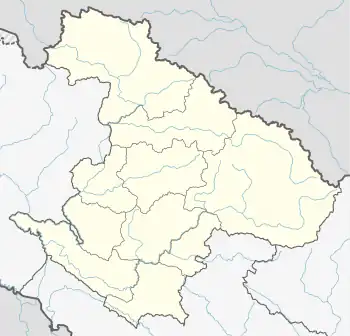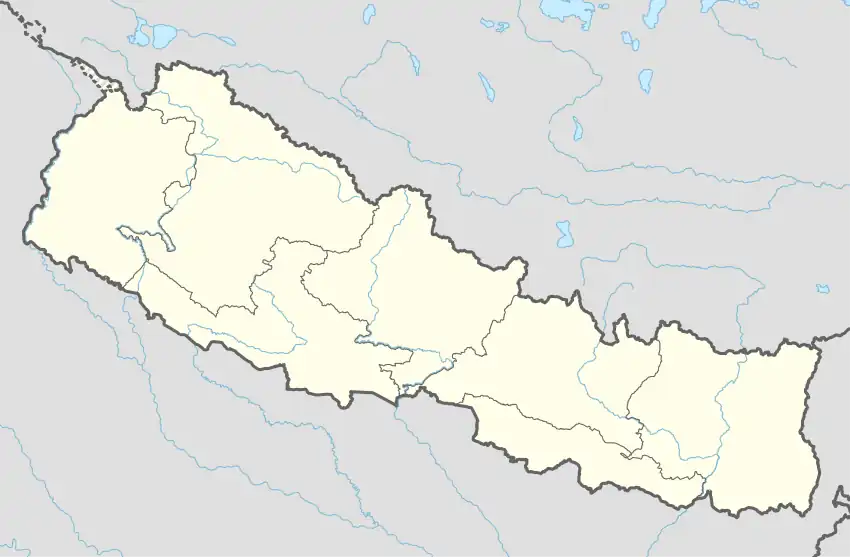Narayan
नारायण | |
|---|---|
 Narayan Location in Nepal  Narayan Narayan (Nepal) | |
| Coordinates: 28°50′43″N 81°42′50″E / 28.84528°N 81.71389°E | |
| Country | |
| Province | Karnali |
| District | Dailekh |
| No. of wards | 11 |
| Established | 26 March 1997 |
| Government | |
| • Mayor | Mr. Ratna Bahadur Khadka (NCP) |
| • Deputy mayor | Mrs. Sabitri Malla (NCP) |
| Area | |
| • Total | 110.63 km2 (42.71 sq mi) |
| Population (2011) | |
| • Total | 27,037 |
| • Density | 240/km2 (630/sq mi) |
| Time zone | UTC+5:45 (NST) |
| Headquarters | Dailekh |
| Website | narayannepal |
Narayan (Nepali: नारायण) is a municipality located in Dailekh District of Karnali Province of Nepal.[1]
The total area of the municipality is 110.63 square kilometres (42.71 sq mi) and the total population of the municipality as of 2011 Nepal census is 27,037 individuals. The municipality is divided into total 11 wards.[2]
The municipality was established on 26 March 1997 merging the then Village development committees of Narayan, Belaspur, Saraswati, Tribhuvan and Basantamala. That time the area of the municipality was 44.26 square kilometres (17.09 sq mi) and the total population of those area was 21,110 (according to the 2011 Nepal census).
On 10 March 2017 Government of Nepal restricted old administrative structure and announced 744 local level units (although the number increased to 753 later) as per the new constitution of Nepal 2015.[3][4] Thus, on 10 March 2017, Bhawani, Bindhyabasini and Kharigaira Village development committees were incorporated with former municipality. The headquarters of the municipality is situated at Dailekh[2]
Demographics
At the time of the 2011 Nepal census, Narayan Municipality had a population of 27,922. Of these, 96.3% spoke Nepali, 3.3% Magar, 0.2% Maithili, 0.1% Tharu and 0.2% other languages as their first language.[5]
In terms of ethnicity/caste, 39.2% were Chhetri, 13.4% Kami, 11.4% Hill Brahmin, 10.6% Magar, 7.8% Thakuri, 7.1% Sarki, 4.6% Damai/Dholi, 2.6% Newar, 1.3% Gurung, 0.9% Sanyasi/Dasnami, 0.4% Badi, 0.2% Tharu, 0.1% Gharti/Bhujel, 0.1% Musalman, 0.1% Tamang, 0.1% other Terai, 0.1% Yadav and 0.3% others.[6]
In terms of religion, 97.7% were Hindu, 1.9% Christian, 0.3% Buddhist and 0.1% Muslim.[7]
In terms of literacy, 71.1% could read and write, 2.9% could only read and 26.0% could neither read nor write.[8]
References
- ↑ "स्थानीय तहहरुको विवरण" [Details of the local level bodies]. www.mofald.gov.np/en (in Nepali). Ministry of Federal Affairs and Local Development. Archived from the original on 31 August 2018. Retrieved 17 July 2018.
- 1 2 "District Corrected Last for RAJAPATRA" (PDF). www.mofald.gov.np. Retrieved 17 July 2018.
- ↑ "New local level structure comes into effect from today". www.thehimalayantimes.com. The Himalayan Times. 10 March 2017. Retrieved 17 July 2018.
- ↑ "New local level units come into existence". www.kathmandupost.ekantipur.com. 11 March 2017. Retrieved 18 July 2018.
- ↑ NepalMap Language
- ↑ NepalMap Caste
- ↑ NepalMap Religion
- ↑ NepalMap Literacy
